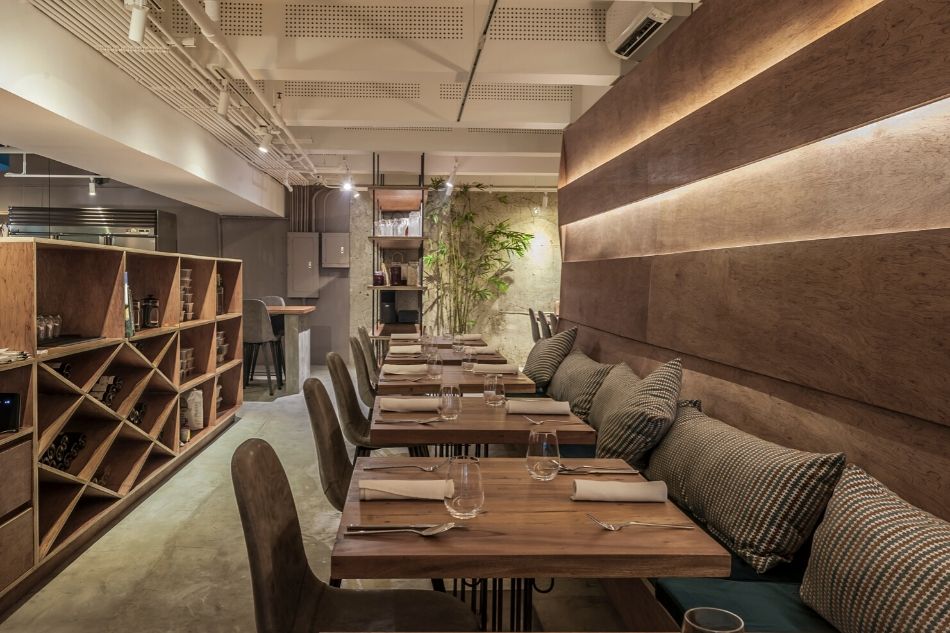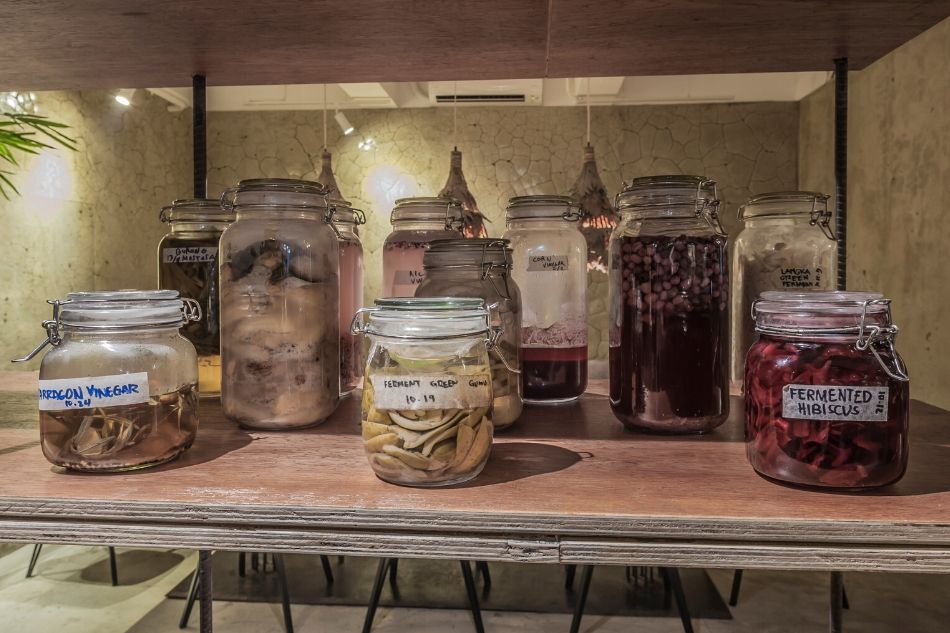Why the food at Metiz is as mestizo as its French- Filipino chef | ABS-CBN
ADVERTISEMENT

Welcome, Kapamilya! We use cookies to improve your browsing experience. Continuing to use this site means you agree to our use of cookies. Tell me more!
Why the food at Metiz is as mestizo as its French- Filipino chef
Why the food at Metiz is as mestizo as its French- Filipino chef
Cyrene de la Rosa
Published Dec 17, 2019 02:17 PM PHT
|
Updated Dec 17, 2019 04:32 PM PHT
With the arrival of Metiz, the newest restaurant to open in Karrivin Plaza, this compound located off Chino Roces Avenue Extension is fast developing into a restaurant enclave for those craving good Filipino food. The area was once known more for its high-end car dealers, wine purveyors, and art galleries rather than for its dining options. But these days, the small compound of three low-lying buildings now boasts The Alley, which houses Chef Jordy Navarra’s award-winning Toyo Eatery and his bread haven Panaderya Toyo, alongside Chef Margarita Forés’s fresh new take on Lanai’s café, now called Lanai Café by M, which serves some Filipino dishes from Forés’s now defunct Café Bola.
With the arrival of Metiz, the newest restaurant to open in Karrivin Plaza, this compound located off Chino Roces Avenue Extension is fast developing into a restaurant enclave for those craving good Filipino food. The area was once known more for its high-end car dealers, wine purveyors, and art galleries rather than for its dining options. But these days, the small compound of three low-lying buildings now boasts The Alley, which houses Chef Jordy Navarra’s award-winning Toyo Eatery and his bread haven Panaderya Toyo, alongside Chef Margarita Forés’s fresh new take on Lanai’s café, now called Lanai Café by M, which serves some Filipino dishes from Forés’s now defunct Café Bola.
You may also like:
You may also like:
- This guerrera turned a major heartbreak into an opportunity to find her inner chef
- VIDEO: We tried the Bangkok sidewalk eatery famous for its oyster omelette and Michelin badge
- This new stall at The Grid is serving Thai street food by a Michelin-starred Thai chef
- The restaurant that turned Chef Josh Boutwood into a culinary star is back
- This guerrera turned a major heartbreak into an opportunity to find her inner chef
- VIDEO: We tried the Bangkok sidewalk eatery famous for its oyster omelette and Michelin badge
- This new stall at The Grid is serving Thai street food by a Michelin-starred Thai chef
- The restaurant that turned Chef Josh Boutwood into a culinary star is back
Adjacent to The Alley is The Moplex, The Moment Group’s headquarters and its office cafeteria called The Mess Hall. Open to the public, this is the place for more casual and cheaper Pinoy fare. In the building across The Moplex, hidden in the back corner is the newly opened Metiz, which has already generated quite a lot of buzz just a few weeks after opening.
Adjacent to The Alley is The Moplex, The Moment Group’s headquarters and its office cafeteria called The Mess Hall. Open to the public, this is the place for more casual and cheaper Pinoy fare. In the building across The Moplex, hidden in the back corner is the newly opened Metiz, which has already generated quite a lot of buzz just a few weeks after opening.
Filipino or not?
Filipino or not?
Metiz’s name comes from the French “métis” and the Spanish “mestizo,” referring to a person of mixed heritage. It works as an apt description of Filipino cuisine and how it is influenced by many cultures. But it also references the restaurant’s young chef-owner, Stephan Roxas Duhesme, who is half-French and half-Filipino.
Metiz’s name comes from the French “métis” and the Spanish “mestizo,” referring to a person of mixed heritage. It works as an apt description of Filipino cuisine and how it is influenced by many cultures. But it also references the restaurant’s young chef-owner, Stephan Roxas Duhesme, who is half-French and half-Filipino.
Metiz isn’t quite a Filipino restaurant, at least not in the traditional sense. According to its Instagram account, it is a “chill little restaurant” that happens to be produce driven and technique centric, and that champions the use of 99.5% local ingredients (except for the occasional use of imported butter), and with a predilection for fermenting different kinds of ingredients.
Metiz isn’t quite a Filipino restaurant, at least not in the traditional sense. According to its Instagram account, it is a “chill little restaurant” that happens to be produce driven and technique centric, and that champions the use of 99.5% local ingredients (except for the occasional use of imported butter), and with a predilection for fermenting different kinds of ingredients.
ADVERTISEMENT
Metiz is gaining a regular clientele of more adventurous diners who are charmed by its creative take on Filipino-located flavors, an ingenious use produce and vegetables, and unusual ingredients mash-ups. For example, unfamiliar and perhaps even polarizing dishes include a salad that uses jackfruit seeds that are usually discarded, as well as a carabao cream dessert with tamarillo fruit that was well received by our group.
Metiz is gaining a regular clientele of more adventurous diners who are charmed by its creative take on Filipino-located flavors, an ingenious use produce and vegetables, and unusual ingredients mash-ups. For example, unfamiliar and perhaps even polarizing dishes include a salad that uses jackfruit seeds that are usually discarded, as well as a carabao cream dessert with tamarillo fruit that was well received by our group.
Diners also appreciate the seemingly good deal they are getting from the restaurant’s prix fixe-only menu—at five courses for just P1,500—considering that the restaurant exerts a big effort to make everything from scratch. I’m also impressed with the speed Metiz comes out with new dishes. On my second visit less than a month after my first one, Duhesme had already changed four out of the six dishes that formed the opening menu.
Diners also appreciate the seemingly good deal they are getting from the restaurant’s prix fixe-only menu—at five courses for just P1,500—considering that the restaurant exerts a big effort to make everything from scratch. I’m also impressed with the speed Metiz comes out with new dishes. On my second visit less than a month after my first one, Duhesme had already changed four out of the six dishes that formed the opening menu.
The chef at play
The chef at play
At the helm of Metiz is 30-year-old, Manila-born, French-Filipino Duhesme. A Kedge Business School graduate-turned-chef, he honed his cooking skills by apprenticing in the kitchens of Purple Yam in Brooklyn, Matsunozushi in Tokyo, Gallery by Chele and its now closed sibling restaurant Arrozeria in Manila. He then opened his first restaurant, Tria Neo Bistro, in Bogota, Colombia where he lived for three years before moving back to Manila.
At the helm of Metiz is 30-year-old, Manila-born, French-Filipino Duhesme. A Kedge Business School graduate-turned-chef, he honed his cooking skills by apprenticing in the kitchens of Purple Yam in Brooklyn, Matsunozushi in Tokyo, Gallery by Chele and its now closed sibling restaurant Arrozeria in Manila. He then opened his first restaurant, Tria Neo Bistro, in Bogota, Colombia where he lived for three years before moving back to Manila.
According to Duhesme, it was during his time in Colombia that he discovered what kind of cook he is and what kind of food he really wants to cook. “I realized I simply enjoyed (and missed) Filipino food. When I came back home, I had access to what I need, to cook what I love to cook,” he says.
According to Duhesme, it was during his time in Colombia that he discovered what kind of cook he is and what kind of food he really wants to cook. “I realized I simply enjoyed (and missed) Filipino food. When I came back home, I had access to what I need, to cook what I love to cook,” he says.
A menu that challenges
A menu that challenges
So what is the food like at Metiz? Guests shouldn’t expect straightforward updates or deconstructed versions of familiar Filipino dishes. For example, Duhesme initially had a pork pata dish that looked like kare-kare as it was made with similar ingredients. But the similarities stopped there as Duhesme played more with the combination of peanuts and bagoong rather than coming up with a tweaked or upgraded version of kare-kare.
So what is the food like at Metiz? Guests shouldn’t expect straightforward updates or deconstructed versions of familiar Filipino dishes. For example, Duhesme initially had a pork pata dish that looked like kare-kare as it was made with similar ingredients. But the similarities stopped there as Duhesme played more with the combination of peanuts and bagoong rather than coming up with a tweaked or upgraded version of kare-kare.
According to Duhesme, a dish is often created based on a flavor, an ingredient, or a concept that he and his team may like, but it is produced following a set of standards that they strictly follow. “It has to be local, it has to be funky, interesting or challenging yet familiar,” says Duhesme. This includes a predilection for bitterness as a flavor. He elaborates, “It’s a very real aspect of Filipino cuisine that is hardly represented in this category of a restaurant and actually considered a no-no in most European countries.”
According to Duhesme, a dish is often created based on a flavor, an ingredient, or a concept that he and his team may like, but it is produced following a set of standards that they strictly follow. “It has to be local, it has to be funky, interesting or challenging yet familiar,” says Duhesme. This includes a predilection for bitterness as a flavor. He elaborates, “It’s a very real aspect of Filipino cuisine that is hardly represented in this category of a restaurant and actually considered a no-no in most European countries.”
Duhesme likes to push the flavor envelope further by using “backyard” ingredients like ampalaya, duhat, talinum, kamias. One dish that I enjoyed was charcoal-grilled, kamias-glazed pork pata on wild pepper leaves, meant to be eaten rolled like a burrito. Note that during my first visit, the pata was glazed with a jackfruit-infused sauce in lieu of kamias.
Duhesme likes to push the flavor envelope further by using “backyard” ingredients like ampalaya, duhat, talinum, kamias. One dish that I enjoyed was charcoal-grilled, kamias-glazed pork pata on wild pepper leaves, meant to be eaten rolled like a burrito. Note that during my first visit, the pata was glazed with a jackfruit-infused sauce in lieu of kamias.
Even less “Filipino” was an extra tasty, foie gras-like, seasoned bone marrow flan lying on top of stir-fried shimeji and shitake mushrooms, and finished with a lace-like tuile (baked paper thin wafer) made of annatto seeds.
Even less “Filipino” was an extra tasty, foie gras-like, seasoned bone marrow flan lying on top of stir-fried shimeji and shitake mushrooms, and finished with a lace-like tuile (baked paper thin wafer) made of annatto seeds.
While Metiz’s menu is bold and experimental, Duhesme hopes to even further challenge himself with new ideas and techniques. “We are constantly trying out things and learning a lot through trial and error. Hopefully, this will give fruit to more exciting things to come,” he promises.
While Metiz’s menu is bold and experimental, Duhesme hopes to even further challenge himself with new ideas and techniques. “We are constantly trying out things and learning a lot through trial and error. Hopefully, this will give fruit to more exciting things to come,” he promises.
G/F Building A, Karrivin Plaza, 2316 Chino Roces Avenue Extension, Makati City, (0917) 898-5751, metizresto@gmail.com, IG @metizresto
Photos by Paul del Rosario
Follow the author on Instagram and Twitter @cyrenedelaros
ADVERTISEMENT
ADVERTISEMENT











